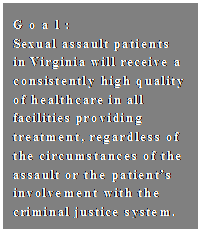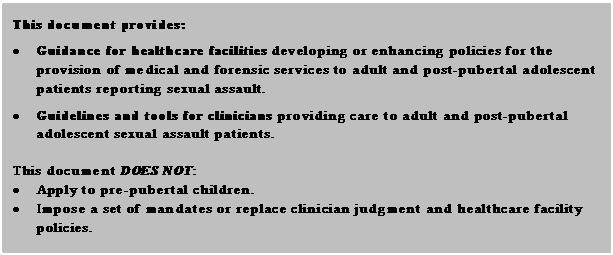The Need for Healthcare Guidelines
Virginia law enforcement agencies received reports of 5,009 forcible sex offenses in 2007 (Virginia Uniform Crime Reporting Program, 2008). The actual number of assaults is thought to be much higher, as reporting rates for sexual assault are relatively low (Rand, 2007). The 12-month incidence of sexual violence among adults in Virginia is estimated to be 2.4 percent, and the lifetime prevalence is 28 percent for adult women and 13 percent for adult men (Virginia Sexual Violence State Plan Advisory Board, 2006). Nationally, 1 in 1,000 persons were victims of rape or sexual assault in 2007 (Rand, 2007).
Clinical guidelines and protocols for the healthcare of sexual assault patients have been issued by national medical, criminal justice, and victim services organizations (AAP, 2008; ACEP, 2002; ACOG, 1997, 1999; AHRQ, 2003; AMA, 1995; Office on Violence Against Women, 2004), providing fairly uniform recommendations for the necessary components of comprehensive medical-forensic care. However, research suggests that the healthcare received by sexual assault patients is inconsistent and often does not adhere to national guidelines (Amey and Bishai, 2002; Campbell, 2006; Campbell and Bybee, 1997; Campbell et al., 2006; Rovi and Shimoni, 2002; Straight and Heaton, 2007). Data from Virginia reflect these national findings (Plichta et al., 2006) and support the need for a consistent approach to caring for sexual assault patients across the Commonwealth.
The Governor’s Commission on Sexual Violence recommended in November 2007 that the Secretaries of Health and Human Services and Public Safety convene a multidisciplinary body to develop a statewide model of care for the acute healthcare response to sexual violence. Subsequently, the Virginia Department of Criminal Justice Services awarded funding to the Virginia Sexual and Domestic Violence Action Alliance (VSDVAA) and the Virginia Chapter of the International Association of Forensic Nurses (VA-IAFN) to facilitate this effort. Throughout 2008 and 2009, VSDVAA and VA-IAFN worked with a multidisciplinary, interagency Advisory Board and Working Group to develop this document. (See Appendix 1 for more information about the development of this document.)
 The goal of this initiative is for sexual assault patients to receive a consistently high quality of healthcare in all facilities providing treatment, regardless of the circumstances of the assault or the patient’s involvement with the criminal justice system. Nearly two decades ago, a similar initiative laid the groundwork for a consistent approach to caring for sexual assault patients in Virginia’s hospitals, with the publication in 1990 of “Virginia’s Hospital Protocol For the Treatment of Sexual Assault Victims.” This new document replaces that protocol. It incorporates current guidelines from national medical and criminal justice organizations for the management of sexual assault patients and the collection of forensic evidence. This document also expands the focus to encompass healthcare settings other than hospitals; an emergency room is not always the first stop for a person who has been sexually assaulted. Healthcare providers in a variety of settings must be prepared to care for sexual assault patients.
The goal of this initiative is for sexual assault patients to receive a consistently high quality of healthcare in all facilities providing treatment, regardless of the circumstances of the assault or the patient’s involvement with the criminal justice system. Nearly two decades ago, a similar initiative laid the groundwork for a consistent approach to caring for sexual assault patients in Virginia’s hospitals, with the publication in 1990 of “Virginia’s Hospital Protocol For the Treatment of Sexual Assault Victims.” This new document replaces that protocol. It incorporates current guidelines from national medical and criminal justice organizations for the management of sexual assault patients and the collection of forensic evidence. This document also expands the focus to encompass healthcare settings other than hospitals; an emergency room is not always the first stop for a person who has been sexually assaulted. Healthcare providers in a variety of settings must be prepared to care for sexual assault patients.
Data on Virginia’s Healthcare Response to Sexual Assault
Plichta et al. (2006) are the first to systematically study the services offered to sexual assault patients by emergency departments in Virginia. (No published data are available on the acute care received by sexual assault patients in other healthcare settings in Virginia.) While nearly all of their respondents routinely offered sexual assault patients testing and treatment for sexually transmitted infections and pregnancy tests, some aspects of recommended medical care—notably emergency contraception and HIV testing 1—were offered less consistently (87% and 82% respectively). Among emergency departments that provided forensic examinations for sexual assault patients, only 66 percent performed all of the recommended components of the forensic exam. While many components of the exam were conducted by at least 90 percent of respondents, only 78 percent of respondents reported that they obtained written consent from the sexual assault patient or photographically documented injuries. Services that support the emotional well-being and comfort of sexual assault patients, such as the presence of a sexual assault crisis center advocate or providing clean clothes and a place to shower after a forensic exam, were offered by only 60 to 80 percent of emergency departments. Fewer than half of Virginia’s emergency departments regularly trained new staff in caring for sexual assault patients, and very few (13%) provided such training for existing staff.
These gaps are particularly noteworthy in light of evidence that provider education and the quality of medical and forensic services have significant effects on patient outcomes, on the likelihood of participation in the criminal justice process, and on the quality of forensic evidence collected (Campbell, Patterson, and Lichty, 2005; Campbell et al., 2006; Nugent-Borakove et al., 2006; Plichta et al., 2006; Sievers, Murphy and Miller, 2003). Anecdotal evidence from healthcare providers, law enforcement officials, and crisis center advocates from around the Commonwealth suggests continued inconsistency in access to trained medical personnel and emergency departments equipped to conduct forensic examinations, often resulting in delays in medical care and evidence collection, poorer quality evidence, and increased trauma to the patient.
Use of This Document
This document addresses the healthcare response to sexual assault at all levels of the system—community, healthcare facility, and individual providers—by providing:
Community-Level
Recommendations that promote institutionalized linkages among stakeholders for greater collaboration and sharing of resources.Facility-Level
Guidance for healthcare facilities in establishing policies that institutionalize system-level relationships and support the provision of high quality medical and forensic services to sexual assault patients.Individual-Level
Tools for clinicians who directly deliver care to patients in the acute period after a sexual assault. Practice guidelines and algorithms outline major process steps and provide guidance on performing these steps in a manner that minimizes further trauma to the patient and maximizes the probability of collecting and preserving evidence for potential use in the legal system.
As indicated by the title, this document provides guidelines for the care of adult and post-pubertal adolescent sexual assault patients only. Pre-pubertal children who have been sexually abused are emotionally as well as physically different from older sexual assault patients and require pediatric medical, forensic, and psychological services. Although guidelines for caring for post-pubertal adolescent sexual assault patients are similar to those for adults, special consideration must be given to issues related to mandatory reporting, consent, and confidentiality. Please see page 6 for a discussion of special considerations for using this document with post-pubertal adolescents.
Application in Different Settings and Communities
This is not a document about forensic nursing programs. Not all communities or facilities can sustain forensic nursing programs. These guidelines are intended to assist healthcare facilities in all communities and regions of Virginia in developing policies for managing sexual assault patients—whether they provide sexual assault examinations on-site or transfer sexual assault patients to other facilities.
Sexual assault patients may present to a variety of healthcare settings, most commonly, but certainly not limited to, hospital emergency departments. In some communities, Forensic Nurse Examiner/Sexual Assault Nurse Examiner programs operate independently of the hospital. Other healthcare facilities that may provide care in the immediate period after a sexual assault include local health department clinics, free clinics, urgent care clinics, military hospitals or clinics, student health centers, and private practices. This document was written to be useful for different types of healthcare facilities. Although specific guidelines may be more relevant to some facilities than others, the overarching elements of a compassionate and effective healthcare response are the same regardless of where the care is provided.
The guidelines presented in this document are goals that all healthcare facilities should work toward and should be able to achieve. In many cases, the precise manner in which these goals are met (e.g., assisting sexual assault patients with transportation, coordinating a response by the local sexual assault crisis center, providing training to healthcare providers) will depend on available resources and community-level factors. Some goals may take more time to achieve than others, but they are all achievable.
In addition to the guidelines, the document identifies best practices. The best practices are ideal elements of a model healthcare response to sexual assault that, unlike the guidelines, may not be feasible for all facilities or communities.

1. The study was conducted prior to the enactment of Virginia’s opt-out screening process for HIV in 2008.